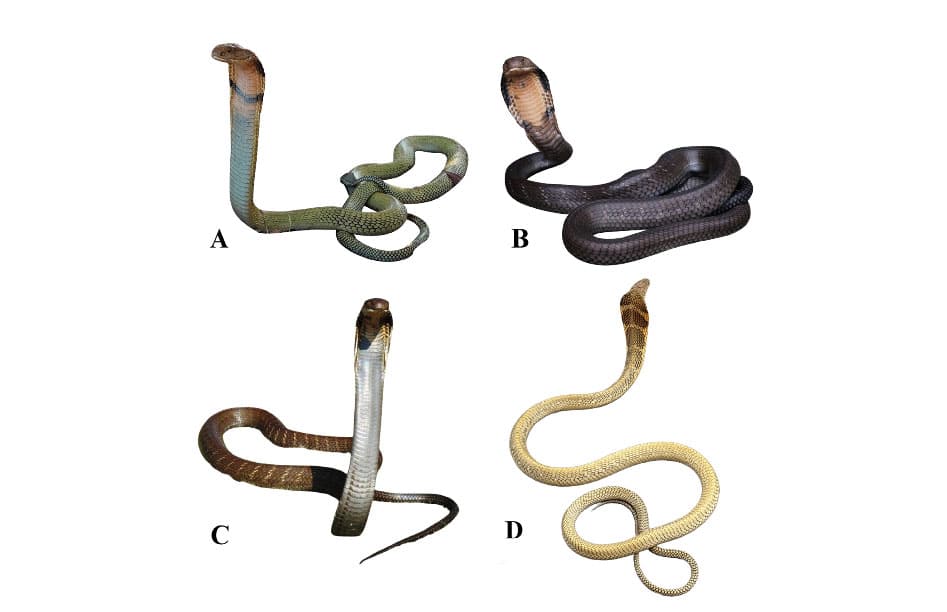The researchers have restricted Ophiophagus hannah s. str. to populations of the snake located in eastern Pakistan, northern and eastern India, central Thailand, Indo Burma, Indo-China, and the Andaman Islands.
The king cobra (Ophiophagus hannah) is no longer the only species in its genus as a team of international researchers have discovered a new king cobra species. In addition, recent studies have determined that the king cobra in the Philippines is a distinct species and as such the researchers have given it a scientific name. The Ophiophagus genus now has four king cobra species.

Live unvouchered adults of Ophiophagus hannah (Cantor, 1836) showing variations in colour pattern. A. Mizoram, India (photo: H.T. Lalremsanga). B. China (Adam Francis). C. Thailand (photo: P. Gowri Shankar). D. Andaman Islands, India (photo: Aaron Fernandes).
The researchers based their findings on reevaluating the taxonomy oof king cobras using “qualitative, mensural and meristic characters, based on 148 entire and five skeletal specimens, and supported by a recent molecular phylogenetic analysis.” This study, which looked at the genetics showed that the snakes were different genetically as well as visually distinct. The researchers looked at body bands, body width, cloacal scale, dental characters, dorsal scale rows, ocular ring, and other defining features to make their assessments, in addition to DNA analysis.

Variation in dorsal body bands in juveniles of the four species of Ophiophagus Günther, 1864 recognised in this study. A. O. hannah (Cantor, 1836) (photo: H.T. Lalremsanga). B. O. bungarus (Schlegel, 1837) comb. nov. (photo: T. Charlton). C. O. kaalinga Gowri Shankar, Das & Ganesh sp. nov. (photo: P. Gowri Shankar). D. O. salvatana Gowri Shankar, Das & Wüster sp. nov. (photo: Bernard Tarun).
The researchers have restricted Ophiophagus hannah s. str. to populations of the snake located in eastern Pakistan, northern and eastern India, central Thailand, Indo Burma, Indo-China, and the Andaman Islands in the Bay of Bengal. The Philippine king cobra (Ophiophagus salvatana Gowri Shankar, Das & Wüster sp. nov) as endemic to the the main Philippine island of Luzon. Recent phylogenetic study has concluded that the Philippine king cobra is a distinct species.
The researchers have described the Western Ghats king cobra (Ophiophagus kaalinga Gowri Shankar, Das & Ganesh sp. nov) as endemic to the Western Ghats region of southwestern India.

Live unvouchered adults of Ophiophagus kaalinga Gowri Shankar, Das & Ganesh sp. nov. showing variation in colour pattern. A. Kalakkad-Mundanthurai Tiger Reserve, India (photo: Naveen Joseph). B–C. Agumbe, Karnataka, India (photo: P. Gowri Shankar). D. Goa, India (photo: P. Gowri Shankar).
The king cobra (Ophiophagus sp.) is arguably the most popular venomous snake in the world. It is an elapid that was previously the only species in its genus. While it is not considered to be a true cobra, it is certainly the most popular. It can deliver a very large amount of venom in a single envenomation, upward of 200 to 500mg of venom. The venom affects the central nervous system, which causes blurred vision, vertigo, drowsiness,and paralysis. It then causes the collapse of the cardiovascular system and eventually respiratory failure. Immediate medical treatment is essential to enhance survival from a king cobra snakebite. It is said that death can come to a person bitten by a king cobra within 30 minutes, depending on the amount of venom delivered during the envenomation.

Live unvouchered adults of Ophiophagus bungarus (Schlegel, 1837) comb. nov. showing variations in colour pattern. A. Peninsular Malaysia (photo: Ahmad Khaldun Ismail). B. Java, Indonesia (photo: Nathan Rusli). C. Bali, Indonesia (photo: Shinta Sukum). D. East Malaysia (photo: P.Gowri Shankar)
The complete paper describing the new species and naming conventions can be read on the European Journal of Taxonomy website.
The king cobra is known as a snake eater, hence the scientific name Ophiophagus (Greek for snake eating) and feeds almost exclusively on other snakes. They are a terrestrial species and live in dense highland forests, open woods and pasturelands near bodies of water. They are the largest venomous snake in the world, often exceeding 16 feet in length.



